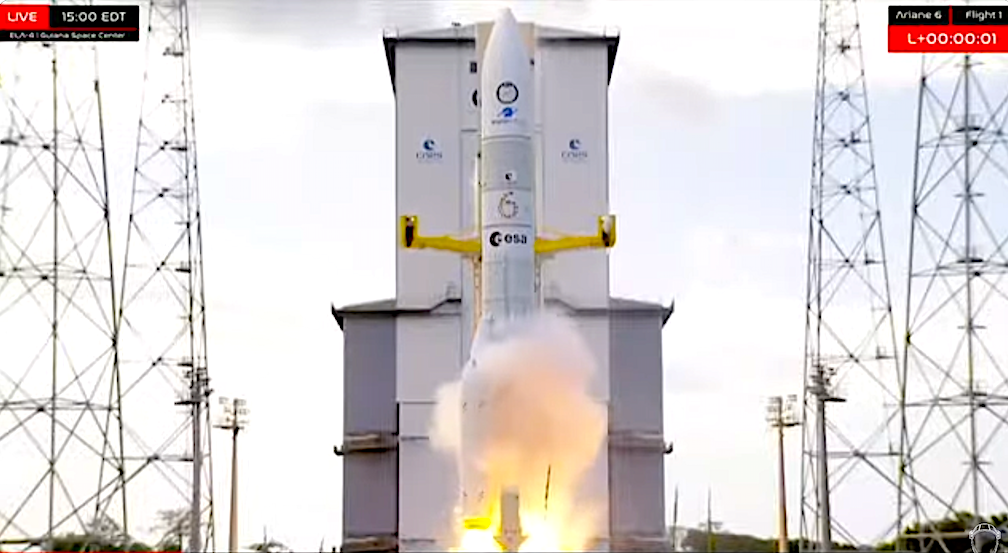
Success in every sense of the word as ESA’s Ariane 6 soared and then separated into the ocean just as planned. Despite a slight delay due to a small data issue the successful launch and subsequent separation created energy in the center as techicians, engineers and others cheered and clapped.

Unlike Falcon 9, Ariane 6 is not a reusable design. A fresh rocket is required for each launch. The ESA has said it does not need a reusable design because few launches are required.
ArianeGroup, a venture of Airbus and Safran, made Ariane 6 for the ESA.
Since the beginning of the Ariane 6 project, formerly Ariane 5 had 40 launches compared with the 200-plus of SpaceX.
The upper part has a rocket engine. This one can fire multiple times, to allow Ariane 6 to deposit payloads at different orbits. A final burn is also used to push this upper stage out of orbit, to avoid becoming space junk.
Ariane 6 will take a group of small payloads into orbit for its first flight, including some German satellites and Nasa’s CubeSat Radio Interferometry Experiment (Curie), designed to measure radio waves emanating from the sun and elsewhere.
UPDATE ESA’s Ariane 6 the day of launch slight delay due to “small” data issue
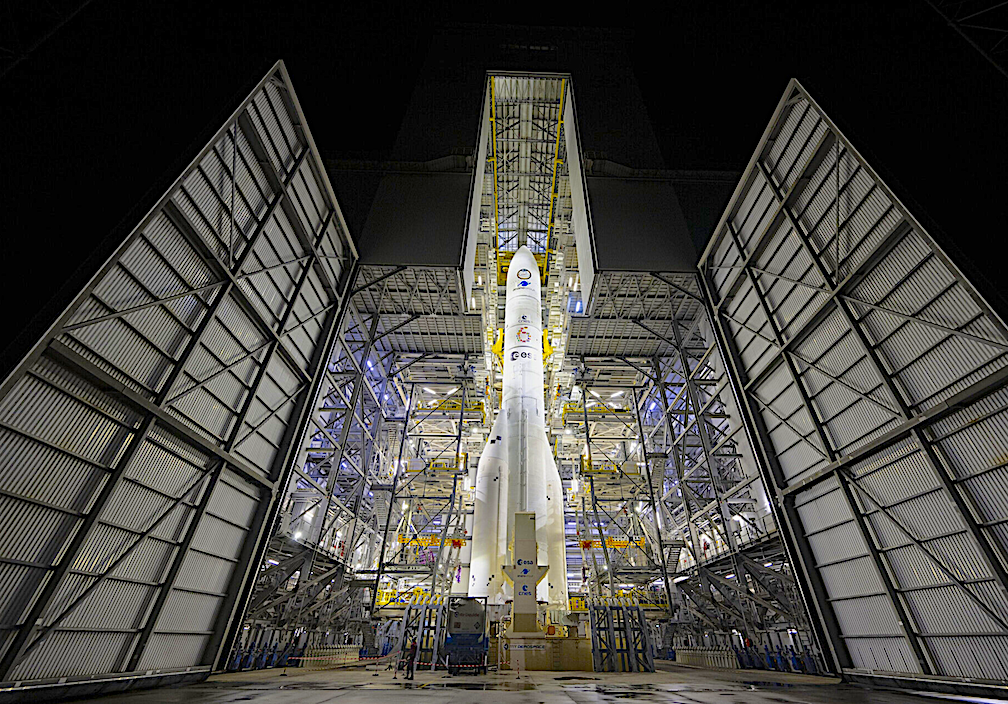
The first Ariane 6 that will be launched into space seen inside its mobile building at Europe’s Spaceport in French Guiana, 9 July 2024, the day of launch. Credit: ESA-S. Corvaja
The planned time for liftoff was delayed by one hour to 4pm local time (1900 GMT) after routine checks revealed a “small” data issue which has been resolved, the ESA said on X. The rocket was officially scheduled to lift off during a four-hour launch window starting at 3:00 p.m. (1800 GMT).
The planned time for liftoff was delayed by one hour to 4pm local time (1900 GMT) after routine checks revealed a “small” data issue which has been resolved, the ESA said on X.
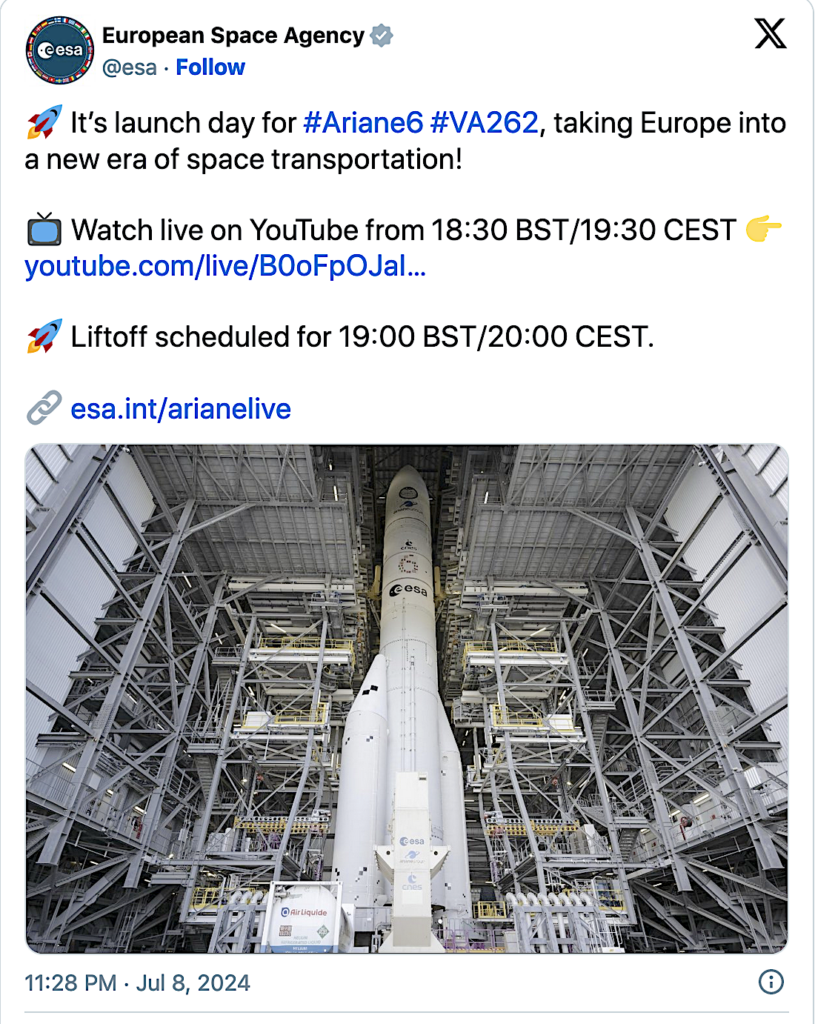
A 10am forecast said that “Weather is GO for fuelling”, the ESA said on X.
This gave the green light for filling the rocket’s tanks with the liquid hydrogen and liquid oxygen that will propel it into space.
There is a great deal of pressure for the launch to succeed as there are many unfortunate issues that occurred in the European space agencies. The statistics reflect that almost half of the first launches of new rockets were unsuccessful.
Franck Saingou, Ariane 6 launch system architect, said there had been so many rehearsals that it all feels “routine — except this time it’s the real thing”.
Despite the success of 117 launches over 20 years there is always a reminder that in 1996 the Ariane 5 exploded after liftoff.
Tony dos Santos, the ESA’s Kourou technical manager, said that teams on the ground would only be able to “breathe our first sigh of relief when the first satellites have been released” an hour and six minutes after liftoff.
ESA’s statement regarding Ariane 6 the day before launch
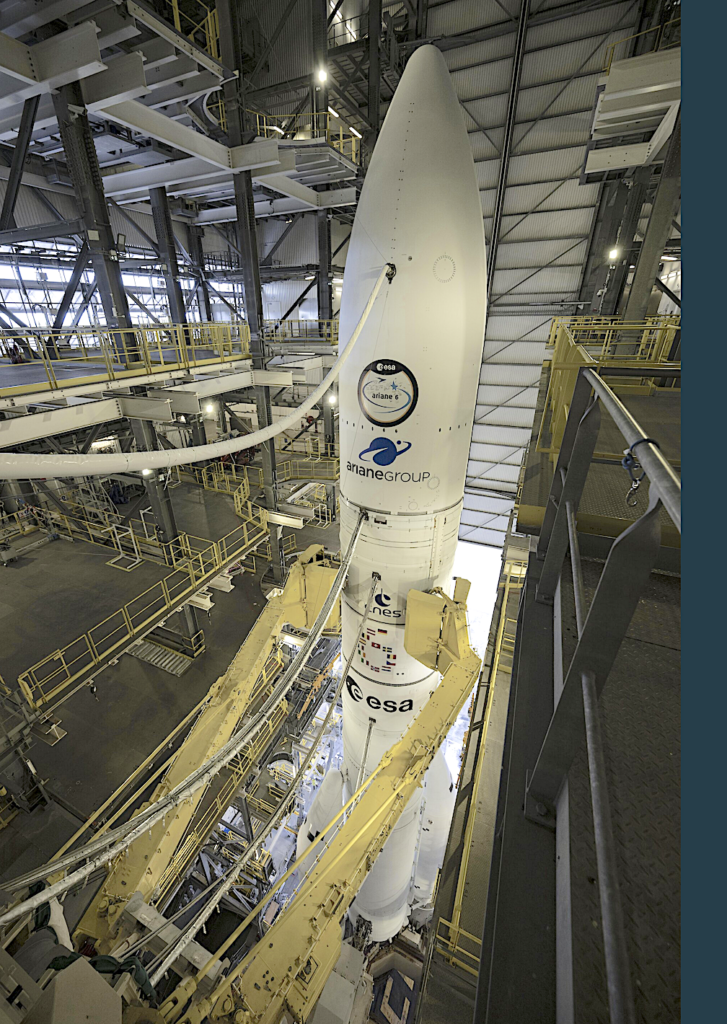
The first Ariane 6 that will be launched into space seen inside its mobile building at Europe’s Spaceport in French Guiana, 8 July 2024, the day before launch.
The final assembly for Europe’s new rocket Ariane 6 is done inside a colossal 90-m tall mobile gantry building.
Hours before liftoff the mobile building rolls 120 m away from the launch pad, allowing Ariane 6 to stand free and be ready for loading of propellant and then liftoff for its first flight designated VA262.
Pumping fuel into an Ariane 6 rocket takes about 3,5 hours, as technicians at the control centre first began by slowly cooling the pipes, valves, tanks and engines from the tropical temperatures in French Guiana of about 30°C down to the super-chilled temperatures of the cryogenic fuels.
As much an art as engineering, the propellants used by Europe’s new rocket Ariane 6 are supercooled to –180°C for the oxygen and –253°C for the hydrogen fuel. At these temperatures, any humidity already in the pipes would immediately freeze and could lead to blocked valves. To avoid this, any hint of air or moisture from the atmosphere is flushed out of the system by the unreactive gas, helium, before fuelling begins.
This Ariane 6 has two boosters set to propel a varied selection of experiments, satellites, payload deployers and reentry demonstrations that represent thousands across Europe, from students to industry and experienced space actors NASA and ArianeGroup.
Ariane 6 is Europe’s newest heavy-lift rocket, designed to provide great power and flexibility at a lower cost than its predecessors. The launcher’s configuration – with an upgraded main stage, a choice of either two or four powerful boosters and a new restartable upper stage – will provide Europe with greater efficiency and possibility as it can launch multiple missions into different orbits on a single flight, while its upper stage will deorbit itself at the end of mission.
ESA’s Ariane 6 set to do the heavy lifting for Arianespace July 9

The Ariane 6 launch vehicle is scheduled to launch on July 9 at 11:00 AM – 3:00 PM PDT, from Guiana Space Centre, French Guiana. The project is an European Space Agency (ESA) program, that is developed by ArianeGroup (Arianespace’s parent company) and its European industrial partners.
Ariane 6 will deliver increased payload performance, plus enhanced flexibility to launch a wide range of missions with the same high reliability demonstrated throughout the Ariane program.
Ariane 6 is Europe’s new heavy lift launch vehicle replacing its extremely successful predecessor, Ariane 5. Modular and agile, Ariane 6 has a reignitable upper stage allowing it to launch multiple missions on different orbits on a single flight.

CNES CEO Philippe Baptiste, ESA Director of Space Transportation Toni-Tolker Nielsen, Director General of the German Space Agency at DLR Walther Pelzer, ArianeGroup CEO Martin Sion, ESA Director General Josef Aschbacher, Arianespace CEO Stéphane Israël, ESA astronaut Samantha Cristoforetti, ESA astronaut Alexander Gerst.
ESA Director General Josef Aschbacher said, “Ariane 6 marks a new era of autonomous, versatile European space travel. This powerful rocket is the culmination of many years of dedication and ingenuity from thousands across Europe and, as it launches, it will re-establish Europe’s independent access to space. I am glad to announce that the first launch attempt will be on 9 July. I would like to thank the teams on the ground for their tireless hard work, teamwork and dedication in this last stretch of the inaugural launch campaign. Ariane 6 is Europe’s rocket for the needs of today, adaptable to our future ambitions.”
The next-generation launch vehicle will be built in two versions: Ariane 62, which is perfectly suited for institutional missions; and Ariane 64, which primarily will serve the commercial market.
The core stage with solid rocket boosters (P120C) propels Ariane 6 in the first 10 minutes of flight to 200 km, delivering 135 tons of thrust in vacuum. The core stage is powered by the liquid-fueled Vulcain 2.1 –an upgraded engine derived from Ariane 5’s Vulcain 2– and either two or four P120C strap-on solid boosters, to provide additional thrust at liftoff.
The upper stage is powered by the reignitable Vinci engine fueled by cryogenic liquid oxygen and hydrogen. This allows Ariane 6 to reach a range of orbits on a single mission, and deliver more payloads. The upper stage will typically burn one, two or more times to reach targeted orbits. After payload separation, the upper stage will perform a de-orbit maneuver, in order to mitigate space debris.
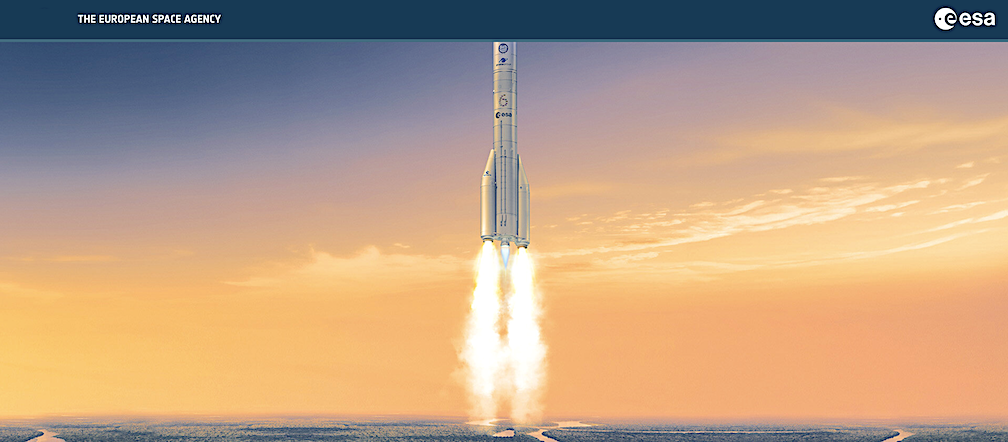
For the development of Ariane 6, ESA is the Launch System Architect working with prime contractor ArianeGroup for the development of the launch vehicle and with CNES for the development of the ground segment. ESA is the operator responsible for the inaugural flight while for subsequent flights Arianespace is the launch service provider that markets and operates the Ariane 6 launcher for institutional and commercial customers to launch a variety of missions into orbit.
“The announcement of the scheduled date for Ariane 6’s first flight puts us on the home stretch of the launch campaign and we are fully engaged in completing the very last steps. This flight will mark the culmination of years of development and testing by the teams at ArianeGroup and its partners across Europe. It will pave the way for commercial operations and a significant ramp-up over the next two years. Ariane 6 is a powerful, versatile and scalable launcher that will ensure Europe’s autonomous access to space,” said Martin Sion, CEO of ArianeGroup.
“Once again, the announcement of the inaugural flight date of Ariane 6 from the Guiana Space Centre is a crucial step towards European sovereignty in terms of access to space. Reaching this date was made possible thanks to the colossal efforts of all entities in the home stretch. I would like to pay tribute the collective achievement of overcoming the pitfalls over the months. Now to the final adjustments before launch. Europe in space is ready for take-off: we’re all united behind Ariane 6!” exclaimed Philippe Baptiste, CEO of CNES.
